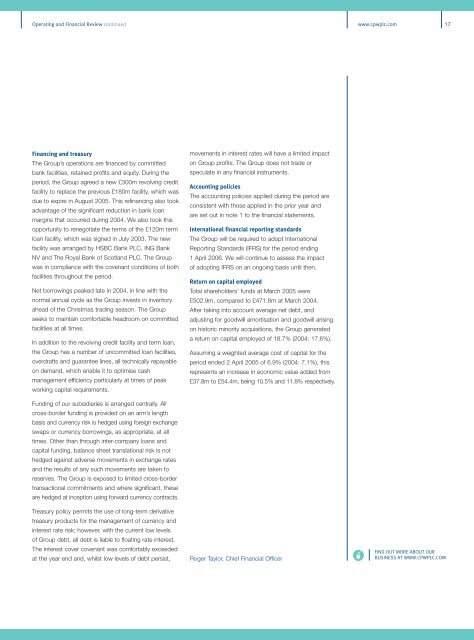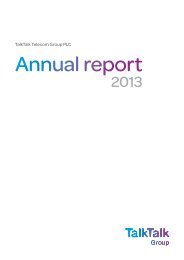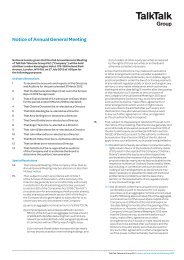The Carphone Warehouse Group PLC Annual Report 2005
The Carphone Warehouse Group PLC Annual Report 2005
The Carphone Warehouse Group PLC Annual Report 2005
Create successful ePaper yourself
Turn your PDF publications into a flip-book with our unique Google optimized e-Paper software.
Operating and Financial Review continued www.cpwplc.com 17<br />
Financing and treasury<br />
<strong>The</strong> <strong>Group</strong>’s operations are financed by committed<br />
bank facilities, retained profits and equity. During the<br />
period, the <strong>Group</strong> agreed a new £300m revolving credit<br />
facility to replace the previous £180m facility, which was<br />
due to expire in August <strong>2005</strong>. This refinancing also took<br />
advantage of the significant reduction in bank loan<br />
margins that occurred during 2004. We also took this<br />
opportunity to renegotiate the terms of the £120m term<br />
loan facility, which was signed in July 2003. <strong>The</strong> new<br />
facility was arranged by HSBC Bank <strong>PLC</strong>, ING Bank<br />
NV and <strong>The</strong> Royal Bank of Scotland <strong>PLC</strong>. <strong>The</strong> <strong>Group</strong><br />
was in compliance with the covenant conditions of both<br />
facilities throughout the period.<br />
Net borrowings peaked late in 2004, in line with the<br />
normal annual cycle as the <strong>Group</strong> invests in inventory<br />
ahead of the Christmas trading season. <strong>The</strong> <strong>Group</strong><br />
seeks to maintain comfortable headroom on committed<br />
facilities at all times.<br />
In addition to the revolving credit facility and term loan,<br />
the <strong>Group</strong> has a number of uncommitted loan facilities,<br />
overdrafts and guarantee lines, all technically repayable<br />
on demand, which enable it to optimise cash<br />
management efficiency particularly at times of peak<br />
working capital requirements.<br />
movements in interest rates will have a limited impact<br />
on <strong>Group</strong> profits. <strong>The</strong> <strong>Group</strong> does not trade or<br />
speculate in any financial instruments.<br />
Accounting policies<br />
<strong>The</strong> accounting policies applied during the period are<br />
consistent with those applied in the prior year and<br />
are set out in note 1 to the financial statements.<br />
International financial reporting standards<br />
<strong>The</strong> <strong>Group</strong> will be required to adopt International<br />
<strong>Report</strong>ing Standards (IFRS) for the period ending<br />
1 April 2006. We will continue to assess the impact<br />
of adopting IFRS on an ongoing basis until then.<br />
Return on capital employed<br />
Total shareholders’ funds at March <strong>2005</strong> were<br />
£502.9m, compared to £471.8m at March 2004.<br />
After taking into account average net debt, and<br />
adjusting for goodwill amortisation and goodwill arising<br />
on historic minority acquisitions, the <strong>Group</strong> generated<br />
a return on capital employed of 18.7% (2004: 17.6%).<br />
Assuming a weighted average cost of capital for the<br />
period ended 2 April <strong>2005</strong> of 6.9% (2004: 7.1%), this<br />
represents an increase in economic value added from<br />
£37.8m to £54.4m, being 10.5% and 11.8% respectively.<br />
Funding of our subsidiaries is arranged centrally. All<br />
cross-border funding is provided on an arm’s length<br />
basis and currency risk is hedged using foreign exchange<br />
swaps or currency borrowings, as appropriate, at all<br />
times. Other than through inter-company loans and<br />
capital funding, balance sheet translational risk is not<br />
hedged against adverse movements in exchange rates<br />
and the results of any such movements are taken to<br />
reserves. <strong>The</strong> <strong>Group</strong> is exposed to limited cross-border<br />
transactional commitments and where significant, these<br />
are hedged at inception using forward currency contracts.<br />
Treasury policy permits the use of long-term derivative<br />
treasury products for the management of currency and<br />
interest rate risk; however, with the current low levels<br />
of <strong>Group</strong> debt, all debt is liable to floating rate interest.<br />
<strong>The</strong> interest cover covenant was comfortably exceeded<br />
at the year end and, whilst low levels of debt persist,<br />
Roger Taylor, Chief Financial Officer<br />
FIND OUT MORE ABOUT OUR<br />
BUSINESS AT WWW.CPW<strong>PLC</strong>.COM










